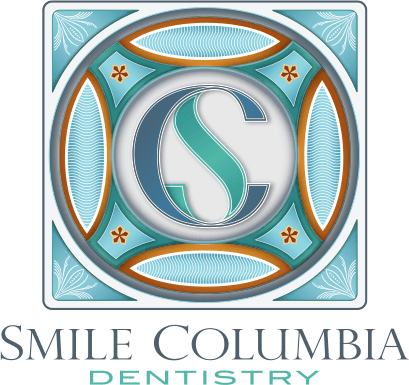Missing teeth can change more than your smile—they can also alter how your jaw functions. When teeth are lost, the bite shifts, forcing the jaw muscles and joints to work harder. Over time, this imbalance can lead to soreness, headaches, and temporomandibular joint (TMJ) pain.
At Smile Columbia Dentistry, Dr. Adam Hahn, DMD, combines advanced TMJ diagnostics with thoughtful restorative planning. This article explains when dental implants can be beneficial, why bite design is important, and how to maintain your results for the long term.
Understanding the Link Between TMJ Health and Missing Teeth
Your TMJ acts like a hinge that guides chewing and speaking. When one or more teeth are missing—especially back teeth—the jaw may close too far or to one side, and the muscles must compensate. That extra effort often creates tension, fatigue, and discomfort.
Restoring missing teeth with well-planned implants can reestablish the spacing and balance your jaw depends on, easing strain on the joints and muscles.
When Dental Implants Can Help
Implants can be an effective part of TMJ care when they’re planned around a balanced bite and healthy jaw position. They restore support, limit shifting, and help share chewing forces more evenly across the mouth.
- Rebuild the vertical space between upper and lower teeth to reduce joint compression.
- Distribute chewing forces to ease muscle overwork and fatigue.
- Prevent neighboring teeth from drifting into the gap and worsening bite imbalance.
- Provide a stable platform for long-term comfort when aligned with your jaw position.
Evaluating Candidacy for Implants in TMJ Patients
Not everyone with TMJ symptoms benefits from implants right away. The first step is to understand the current condition of the joints and muscles, so that permanent restorations support comfort rather than conflict with it.
Comprehensive Neuromuscular Evaluation
Dr. Hahn utilizes technology to determine your most natural and comfortable bite before planning your implants. This allows treatment to support how your jaw wants to work, not how it’s compensating today.
- K7 jaw tracking records how your jaw moves when it opens, closes, and rests.
- TENS therapy gently relaxes facial muscles to reveal a low-tension position.
- Digital scans and imaging document bite height, tooth positions, and joint alignment.
Stabilizing the Bite Before Implant Placement
If your bite is unstable or muscles are inflamed, a short phase of TMJ therapy often comes first. This step helps confirm a comfortable jaw position that can be used to guide the placement of implants.
- A custom orthotic allows muscles to relax and relieves day-to-day strain.
- Symptoms are monitored until comfort and stability are consistent.
- Once the jaw position is confirmed, implant planning begins.
How Dental Implant Bite Design Supports TMJ Health
A successful implant isn’t just about filling a space—it’s about restoring harmony. The way your upper and lower teeth meet determines how force travels through the joints and muscles.
Why Implant Occlusion Is Different From Natural Teeth
Natural teeth have tiny ligaments that cushion bite pressure; implants are anchored directly to bone. Because they don’t have that built-in “shock absorber,” their contacts must be engineered carefully to protect both the restorations and the TMJ.
- Slightly lighter contacts on implant crowns help prevent overload.
- Even force sharing across both sides reduces muscle guarding and headaches.
- Balanced guidance during side-to-side movements lowers joint stress.
Precision Technology for Bite Alignment
Before finalizing your restorations, Dr. Hahn uses digital tools to map your most comfortable jaw position and align your bite with it. That blend of planning and technology supports predictable comfort and function.
- Computerized jaw-tracking helps define an ideal, low-tension bite.
- 3D imaging guides precise implant angulation and spacing.
- Custom crowns and bridges are shaped to maintain that neuromuscular “sweet spot.”
What To Expect During and After Implant Treatment
TMJ patients follow a carefully guided sequence so comfort and function stay on track from planning through final adjustment.
The Implant Process for TMJ Patients
Your journey includes planning, placement, and fine-tuning. Each step is designed to support the jaw position confirmed during your evaluation.
- Planning and imaging capture jaw measurements and bite records.
- Placement and healing allow the implants to integrate with bone.
- Restoration adds custom crowns or bridges designed to your established bite.
- Adjustment ensures even contacts so no area carries excess pressure.
Early Healing and Adjustment
As your muscles adapt to improved support, mild soreness or tightness is common for a few days. Simple habits help the transition feel smooth.
- Favor softer foods at first and avoid heavy chewing on new restorations.
- Continue any prescribed orthotic until your bite is re-checked.
- Report new clicking, locking, or bite changes so they can be addressed promptly.
Protecting Your Implants and Jaw Long-Term
With the proper habits, implants can last for decades, and your jaw can stay comfortable. TMJ-aware maintenance focuses on protecting both the restorations and the joints.
Nightguards and Orthotics
Some patients benefit from continuing a protective appliance after treatment, especially if clenching or grinding shows up at night. A simple guard can make a noticeable difference in how you feel in the morning.
- Diffuses bite force to reduce stress on joints and restorations.
- Helps prevent chips or wear on crowns and bridges.
- Supports the jaw in its optimal position during sleep.
Regular Maintenance and Check-ups
Routine care helps maintain a balanced bite and keeps your implants healthy. Minor adjustments made during regular visits can prevent small issues from developing into major problems.
- Professional cleanings and bite evaluations should be performed every three to six months.
- Periodic occlusion checks to catch minor shifts early.
- Guidance on home care tools, such as floss threaders or water flossers, for use around implants.
If you are transitioning from temporary orthotics to permanent restorations, this refinement process is part of Phase II TMJ treatment, which helps maintain a comfortable and stable bite.
When Implants May Not Relieve TMJ Symptom
Implants restore function, but they aren’t a cure-all for TMJ pain. In some cases, symptoms may stem from joint inflammation, arthritis, or muscle tension that must be addressed concurrently with or before implant therapy.
- Persistent clenching requires management to prevent forces from overwhelming the joints.
- Advanced joint changes may require additional therapies beyond tooth replacement.
- Active muscle inflammation should calm before moving to permanent restorations.
Dr. Hahn’s evaluation is designed to identify these variables early, so your plan supports long-term comfort as well as a confident smile.
A Balanced Bite for a Healthier Smile
Dental implants can restore missing teeth and help stabilize your bite when they’re planned around a low-tension jaw position. With careful diagnostics, thoughtful bite design, and ongoing protection, most patients enjoy a natural-feeling, comfortable result.
If you are experiencing TMJ discomfort and missing teeth, we can help you determine whether dental implants are part of your treatment plan. Call our Columbia, SC office at (803) 781-9090 or click the button below to schedule a consultation and explore a balanced, long-term path to relief.





